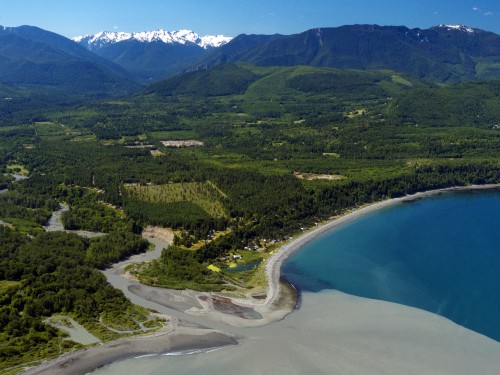Elwha: rebirth of a rainforest river

It’s been hardly a year since the last concrete remnants of the Elwha Dam were removed and already the rebirth of the rainforest river is underway. While most people watching the Olympic Peninsula experiment have been excited about what they hope will soon move upriver—steelhead and all five species of Pacific salmon—the first chapter in the river’s restoration has been more about what is moving downriver: sediment, up to 34 million cubic yards of it in total, with the motherlode of that amount still trapped behind the 2/3rds-demolished Glines Canyon Dam.
“Scientists recently learned there was about 41 percent more sediment trapped behind the dams than originally thought,” reports The Seattle Times’ Lynda Mapes, who recently published Elwha: A River Reborn, “and that the river is transporting more mud and wood than they expected.”
The flushing of the river’s channel, after being pent up behind two dams for the last 100 years, is creating new ecological dynamics that have scientists scrambling to keep up. Fish are adapting to murky waters by pioneering new side channels and feeder streams. Riverbank erosion has been chaotic and unpredictable. And down at the river’s mouth, where the Elwha’s glacially-fed freshwater merges with saltwater at the Strait of Juan de Fuca, all kinds of interesting things are happening: dramatic loss of kelp beds under smothering sand, making way for ecologically-valuable sea grass pastures; a new sand spit emerging, one-third of a mile long and expanding; reinvigorated habitat for important species like sea smelt and sand lance.
It’s only the beginning of an audacious experiment, the demolition of two century-old dams and restoration of a river, a $325 million endeavor that will open up more than 70 miles of pristine spawning habitat. It’s the largest dam removal project in the world, undertaken in a part of the world renowned for harnessing its raging rivers for hydropower, shipping and agriculture.
Americans, industrious to a fault, have built 75,000 dams across the country, or “one large dam a day, every single day, since the Declaration of Independence” according to Bruce Babbitt, Secretary of the Interior under President Clinton.
In a 1989 speech, Babbitt entreated Americans to visualize “an entirely new era of conservation history, moving beyond preservation or protection towards a deeper, more complex movement: the affirmative act of restoration.”
“The coming age of restoration requires…a creative act; we must see not only what is, but envision what can be,” Babbitt explained. “It requires us to reach back into our history in order to grasp the future in which we might live.”
The process to dismantle the dams and invite back salmon may have been inspired by “creative acts of envisioning what can be” but it took more than 25 years of political wrangling, protests and lawsuits, scientific studies, financial negotiations and, ultimately, bipartisan support in Congress to become a reality.
Now comes the best part: watching the 45-mile-long river and its 321-square-mile watershed readjust to its post-impoundment reality, and witnessing, in turn, the rippling reactions across the web of interconnected species—from the caddis fly in the cobble to the spotted owl in the canopy, as well as river otters, bald eagles, rainbow trout, elk, black bear, salamanders and songbirds.
FREE EVENTS
“Elwha Restoration Revealed” lecture and documentary film
Wednesday, April 10, 7 p.m.
WWU’s Academic Instructional West building, room 204
More info at http://elwhawwu.eventbrite.com/?ref=estw
Lynda Mapes reads from Elwha: A River Reborn
Wed., May 22 at 7pm,
Village Books, 1200 11th Street, Bellingham
villagebooks.com
Photo by John Gussman: elwhafilm.com. Originally published in the Cascadia Weekly.

